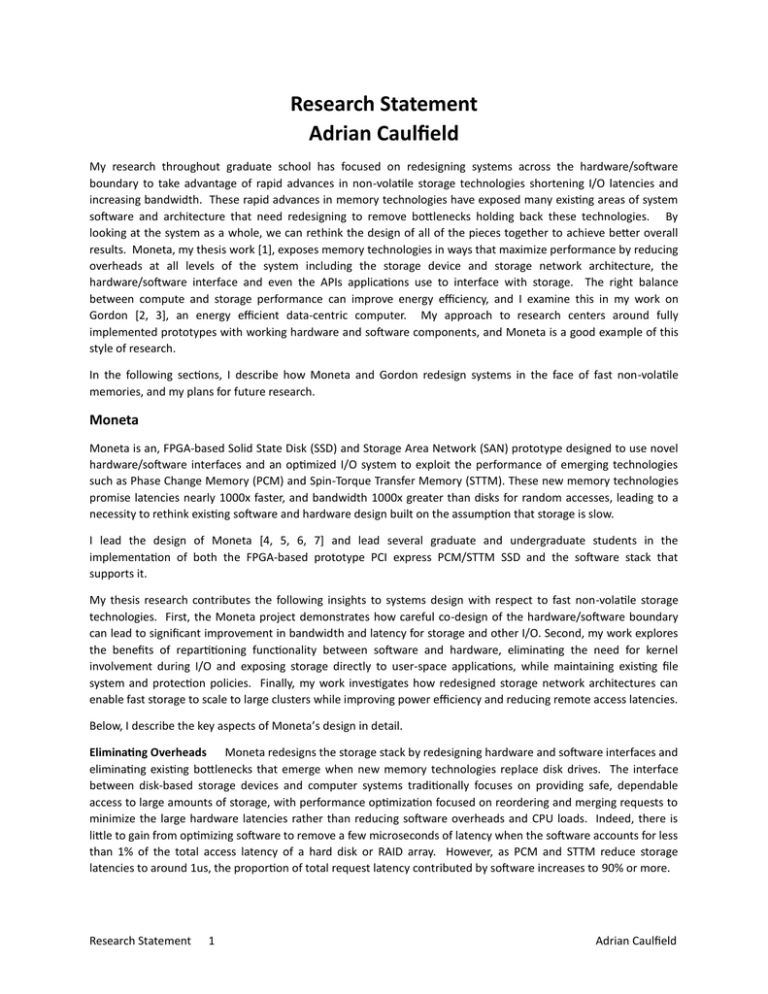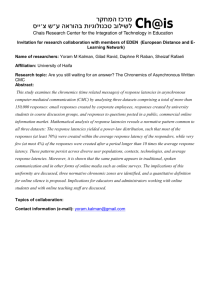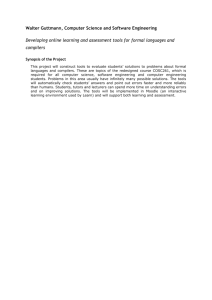Research Statement Adrian Caulfield
advertisement

Research Statement Adrian Caulfield My research throughout graduate school has focused on redesigning systems across the hardware/software boundary to take advantage of rapid advances in non-volatile storage technologies shortening I/O latencies and increasing bandwidth. These rapid advances in memory technologies have exposed many existing areas of system software and architecture that need redesigning to remove bottlenecks holding back these technologies. By looking at the system as a whole, we can rethink the design of all of the pieces together to achieve better overall results. Moneta, my thesis work [1], exposes memory technologies in ways that maximize performance by reducing overheads at all levels of the system including the storage device and storage network architecture, the hardware/software interface and even the APIs applications use to interface with storage. The right balance between compute and storage performance can improve energy efficiency, and I examine this in my work on Gordon [2, 3], an energy efficient data-centric computer. My approach to research centers around fully implemented prototypes with working hardware and software components, and Moneta is a good example of this style of research. In the following sections, I describe how Moneta and Gordon redesign systems in the face of fast non-volatile memories, and my plans for future research. Moneta Moneta is an, FPGA-based Solid State Disk (SSD) and Storage Area Network (SAN) prototype designed to use novel hardware/software interfaces and an optimized I/O system to exploit the performance of emerging technologies such as Phase Change Memory (PCM) and Spin-Torque Transfer Memory (STTM). These new memory technologies promise latencies nearly 1000x faster, and bandwidth 1000x greater than disks for random accesses, leading to a necessity to rethink existing software and hardware design built on the assumption that storage is slow. I lead the design of Moneta [4, 5, 6, 7] and lead several graduate and undergraduate students in the implementation of both the FPGA-based prototype PCI express PCM/STTM SSD and the software stack that supports it. My thesis research contributes the following insights to systems design with respect to fast non-volatile storage technologies. First, the Moneta project demonstrates how careful co-design of the hardware/software boundary can lead to significant improvement in bandwidth and latency for storage and other I/O. Second, my work explores the benefits of repartitioning functionality between software and hardware, eliminating the need for kernel involvement during I/O and exposing storage directly to user-space applications, while maintaining existing file system and protection policies. Finally, my work investigates how redesigned storage network architectures can enable fast storage to scale to large clusters while improving power efficiency and reducing remote access latencies. Below, I describe the key aspects of Moneta’s design in detail. Eliminating Overheads Moneta redesigns the storage stack by redesigning hardware and software interfaces and eliminating existing bottlenecks that emerge when new memory technologies replace disk drives. The interface between disk-based storage devices and computer systems traditionally focuses on providing safe, dependable access to large amounts of storage, with performance optimization focused on reordering and merging requests to minimize the large hardware latencies rather than reducing software overheads and CPU loads. Indeed, there is little to gain from optimizing software to remove a few microseconds of latency when the software accounts for less than 1% of the total access latency of a hard disk or RAID array. However, as PCM and STTM reduce storage latencies to around 1us, the proportion of total request latency contributed by software increases to 90% or more. Research Statement 1 Adrian Caulfield The Moneta operating system I/O stack eliminates I/O scheduling, request queuing, context switching during operations and locking from the I/O path to eliminate software overheads originally introduced to improve performance of slow disk-based storage. Additionally, co-designing the hardware/software interface between the host and device allows for more flexibility to find the right interface to maximize performance or energy efficiency. For example, Moneta’s hardware interface allows request issuing from any number of threads at once without the need for locks. Using limited hardware resources to replace software components on the critical path can provide large performance improvements for storage and other devices. Moneta’s optimized kernel I/O routines reduce software overheads significantly, but file system, buffer-cache and context-switching overheads quickly become the next bottlenecks. Moneta-Direct [5] rethinks the partitioning of work between software and hardware by splitting protection policy definition and enforcement, and moving the protection enforcement into the hardware. With the help of a virtualized interface, it allows every application to issue and complete I/O requests directly from userspace, thus eliminating completely kernel and file system overheads for most accesses. In Moneta-Direct, the kernel and file system retain control of protection policy by allowing only the kernel to install permission records into the hardware to grant an application access to a range of blocks. Unmodified file-systems provide extent information for both the permissions entries and for a user-space cache of file-offset to physical location tuples. This approach allows Moneta-Direct to provide significant latency reductions and bandwidth improvements by removing the requirement to invoke the kernel on every I/O access. By optimizing applications to take advantage of asynchronous I/O and Moneta-Direct’s user-space access, we can further reduce the CPU load for I/O. An additional side effect of increasing storage performance is the additional load placed on the CPU. While Moneta’s optimized I/O stack reduces the amount of code run per I/O operation, moving from several hundred I/O Operations per Second (IOPS) to several million IOPS ends up increasing the total load on the system for I/O intensive applications. Additionally, applications receive I/O responses more quickly and thus have less idle/processing time per request. This upsets the balance between application’s work and I/O response time, with many applications that were once completely I/O bound becoming CPU bound. Scalable Storage PCI express attached storage provides low latencies and high bandwidth, but the storage is only accessible to the host machine containing the card. Additionally, PCI express based storage cannot be easily incorporated into Storage Area Networks which would allow access to many devices from any number of hosts. We extended Moneta by directly integrating a network interface into the storage controller [7], allowing each Moneta device to talk to other Moneta devices over an Ethernet network, while still allowing the use of the user-space accesses described above. Connecting Moneta devices in each host to a storage area network has three advantages over standalone networked storage devices and storage shared through software services. First, by moving the network interface into the same hardware as the storage, it allows aggregating storage across multiple boxes transparently, providing scalable storage capacity and automatic data replication for redundancy across multiple devices. Second, because Moneta has built in protection enforcement, each Moneta can act as a protected gateway to the network allowing enforcement of access policy in a distributed, software-free way, and therefore allowing verified access directly from user-space to remote storage. Finally, Moneta nodes can service requests entirely without host intervention, allowing idle hosts to save power by turning off, while the rest of the cluster retains access to the storage connected to that powered-down node, greatly increasing the efficiency of the whole system. Having access to both locally attached storage and low latency remote storage opens the possibility of exposing the location of data to the application or file system so it can place data appropriately. MapReduce based workloads are a good example of where this type of locality aware placement makes sense, and indeed existing file-systems such as GoogleFS do take advantage of this. Moneta devices with direct access to the network make remote and local access to data both faster and more transparent to the application. Research Statement 2 Adrian Caulfield Gordon Gordon [3, 2] architects a flash memory based data-centric computer, optimized for power efficiency while tackling big data problems. High powered, fast CPUs paired with disk based storage perform computation quickly, but also spend large amounts of timing idling while waiting for I/O requests to complete in between computations. Some low powered CPUs coupled with fastest flash based storage are unable to saturate the I/O bandwidth of the storage. By tuning the CPU type and speed and the storage array architecture we can find an optimal, powerefficient data-centric computer tuned for large I/O intensive applications. The result of Gordon’s design space exploration found that using several low-power Atom processors coupled with a highly optimized flash array and a small amount of DRAM delivers the best power efficiency. Gordon’s low power usage enables a small form factor design with 256GB of flash on each node, and 4TB of storage in a 2U rack enclosure capable of providing 14.4GB/s of I/O throughput. By architecting the system to match the throughput available from the flash memory with the performance of the processor we were able to build a highly efficient system in much the same way that we optimized Moneta to better match the software overheads with the performance of the raw storage. By balancing the performance of system components, we can build power efficient, scalable designs that meet the demands of big data. Future Research The style of research I prefer spans both hardware and software, finding solutions to research questions that make full use of the resources available in both. Finding the right balance between hardware and software and designing the right interfaces to communicate between the two offers a wealth of challenges and interesting research potential. I see two main directions for my future research. First, there are still interesting application- and compiler-level optimizations for high-performance storage. Second, I would like to explore the potential of extremely power-efficient embedded storage devices. Just-In-Time IO As storage latencies approach memory latencies, compilers and programming languages need to integrate storage as a new class of memory, directly accessible with accesses optimized just as a compiler would optimize DRAM accesses. Compiler support for storage exposes several optimization opportunities including statically scheduling I/O requests, optimizing data sizes and layouts in storage, and decreasing I/O software overheads. Just-in-time IO schedulers could also adapt to the specific storage layout and interfaces on the system. At compile time, the compiler is free to reorder I/O requests as long as the correctness of the application remains unchanged. With knowledge of the likely access patterns and relative data locations and sizes, the compiler may be able to merge or eliminate requests, generating a much more efficient stream of requests than would otherwise have been possible. Compilers could also optimize the layout of an application’s data in the storage device, rather than requiring the programmer to decide on the data layout, resulting in potentially sub-optimal access patterns. Current programming languages rely on memory mapping data structures to allow applications and compilers to work with on-disk structures, but compilers know nothing about whether the structures are on disk or in memory and can’t optimize them accordingly. Compilers could also perform register allocation on DMA buffers to statically allocate resources for specific I/O requests, reducing software overheads for those operations. Compiler optimizations for storage would provide benefits to a wide range of applications and devices. In database servers the compiler, combined with low-latency storage, would eliminate the need for much of the existing I/O optimization and buffering by taking advantage of static I/O scheduling and prefetching. The compiler’s ability to detect locations where I/O could be prefetched and use asynchronous I/O would improve request times. For mobile devices, compilers could help schedule I/O requests to happen in bursts to reduce the length of time memories must be powered on. They could also reduce power usage by reducing the amount of data that is actually stored and transferred by removing redundant fields in data structures and merging I/O request sequences into single transfers. Research Statement 3 Adrian Caulfield Mobile Storage Mobile and embedded platforms should tailor storage by balancing the architecture, power and performance of the storage along with the rest of the system and designing the right interfaces for efficient access to storage. Many mobile platforms have thick software layers to allow application sand-boxing and increase system security, but these software layers can limit application performance through restrictive I/O interfaces. Moneta’s user-space interfaces would allow applications to benefit from low-latency storage without needing to sacrifice system security. File system performance plays a large role in mobile storage performance as well, and file systems designed specifically for low-latency mobile storage could ensure that data is arranged in an optimal way to aide in allowing low-overhead user-space access to the data. The compiler approach described above would also have significant benefits here, reducing CPU time spent handling I/O and allowing the compiler to manage the storage hierarchy and produce more efficient I/O request streams using static scheduling at compile time. With embedded applications placing different demands on storage, balancing storage and processing performance using different memory technologies, or hierarchies of several technologies, can improve overall system efficiency. Improvements in hardware efficiency also have indirect benefits, i.e., keeping applications responsive allows users to complete tasks more quickly saving power from network radios and screens as well. Some possible approaches to balancing storage include shifting storage request handling between software and hardware components; applying faster and lower-power but less dense or cheaper memories as caches or alternate data stores; and varying the number of storage devices to alter the amount of parallelism available. A hierarchy of PCM and flash would require sophisticated management algorithms to maintain the ideal placement of data between the different memories. Applications or compilers could provide hints about desired performance to help guide data into the right memories. Mobile devices can also tune storage performance by changing the number of instances of a memory technology to alter the available parallelism. This effectively trades off power and performance, enabling reading and writing to storage with higher bandwidth and lower latencies while managing power requirements. By combining one or more of these techniques, we can match the storage performance with the CPU performance to minimize idle CPU time and maximize system responsiveness and efficiency. References [1] A. M. Caulfield, Thesis, expected 2013. [2] A. M. Caulfield, L. M. Grupp and S. Swanson, "Gordon: An Improved Architecture for Data-Intensive Applications," IEEE Micro, vol. 30, no. 1, pp. 121-130, 2010. [3] A. M. Caulfield, L. M. Grupp and S. Swanson, "Gordon: Using Flash Memory to Build Fast, Power-efficient Clusters for DataIntensive Applications," in ASPLOS '09: Proceeding of the 14th international conference on Architectural support for programming languages and operating systems, Washington, D.C., 2009. [4] A. M. Caulfield, A. De, J. Coburn, T. I. Mollov, R. K. Gupta and S. Swanson, "Moneta: A High-performance Storage Array Architecture for Next-generation, Non-volatile Memories," in MICRO 43: Proceedings of the 43rd Annual IEEE/ACM International Symposium on Microarchitecture, Atlanta, GA, 2010. [5] A. M. Caulfield, T. I. Mollov, L. Eisner, A. De, J. Coburn and S. Swanson, "Providing Safe, User Space Access to Fast, Solid State Disks," in ASPLOS '12: Proceeding of the 17th international conference on Architectural support for programming languages and operating systems, London, UK, 2012. [6] A. M. Caulfield, J. Coburn, T. I. Mollov, A. De, A. Akel, J. He, A. Jagatheesan, R. K. Gupta, A. Snavely and S. Swanson, "Understanding the Impact of Emerging Non-volatile Memories on High-performance, IO-Intensive Computing," in SC'10: Proceedings of the Conference on High Performance Computing Networking, Storage and Analysis, New Orleans, LA, 2010. [7] A. M. Caulfield and S. Swanson, "QuickSAN: A Storage Area Network for Fast, Distributed, Solid State Disks," in In Submission. Research Statement 4 Adrian Caulfield






